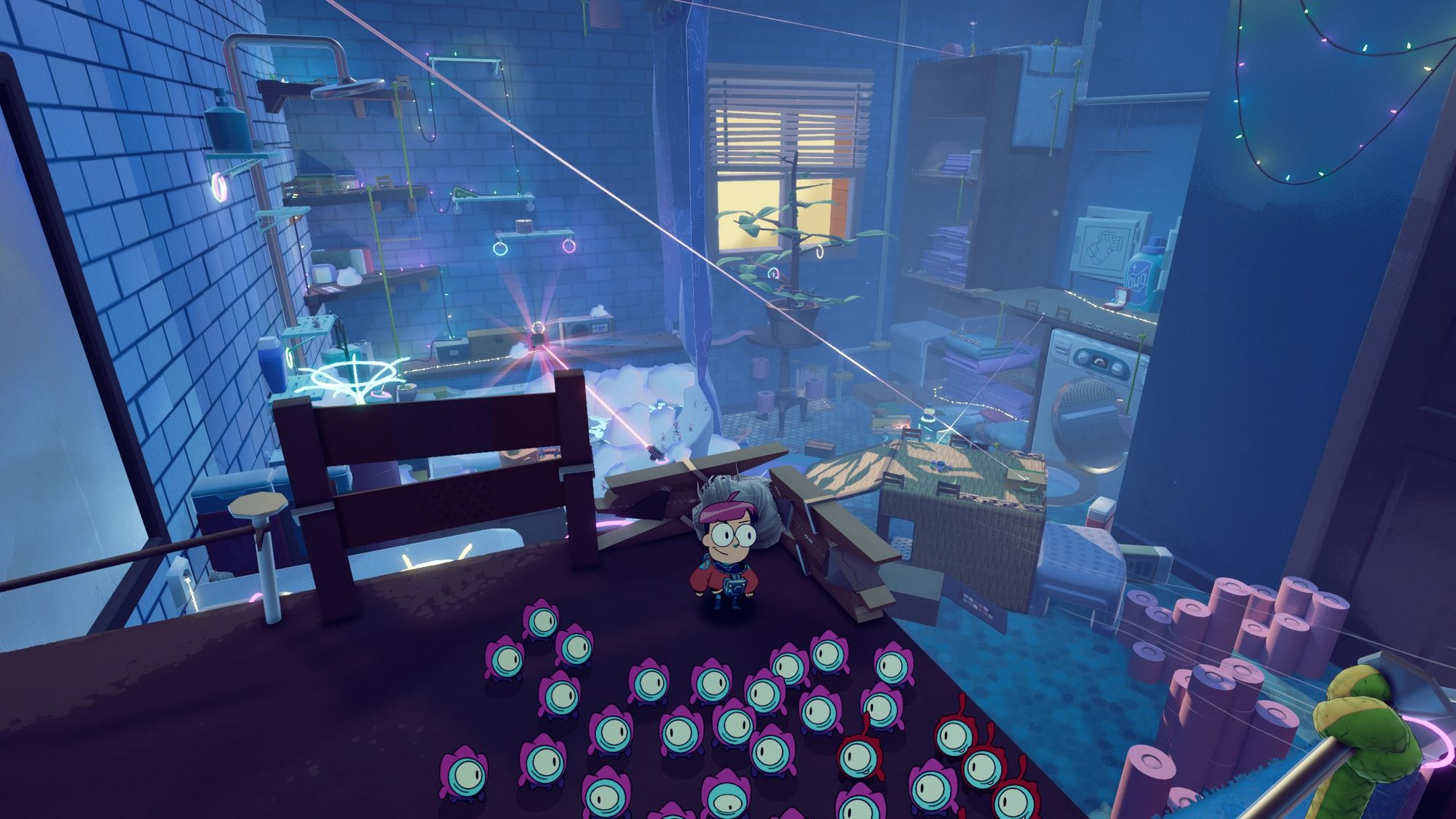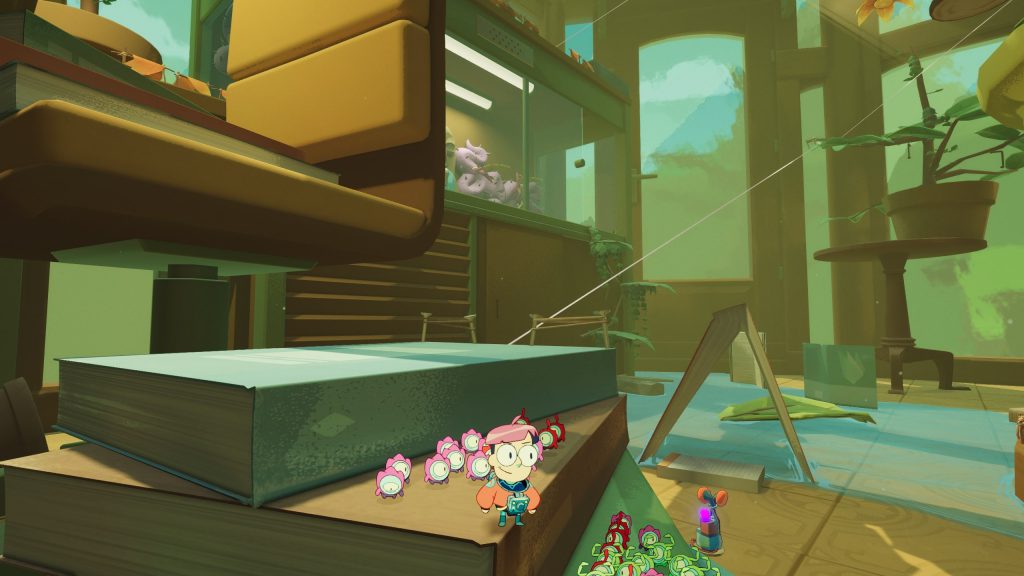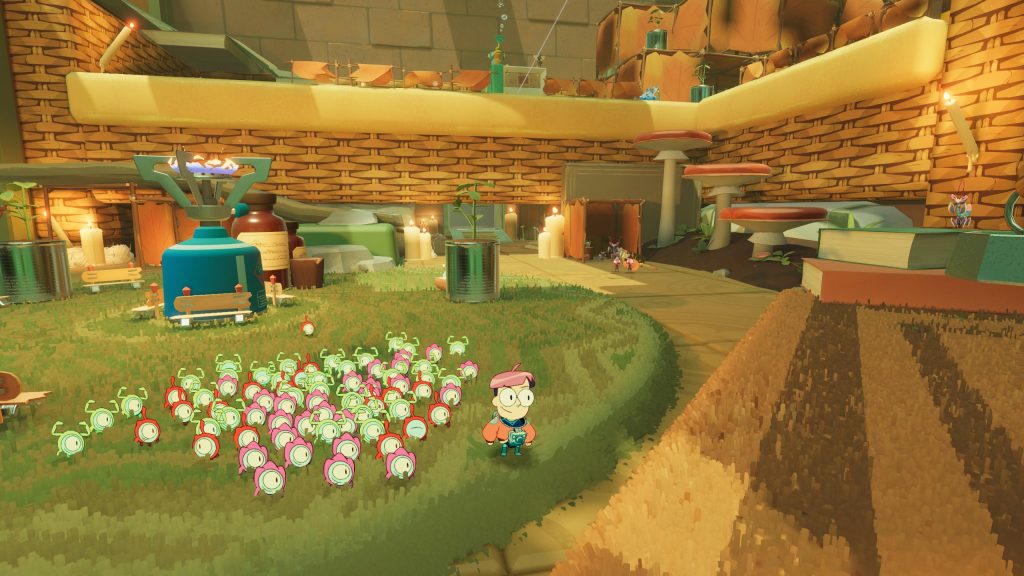
It’s rare to encounter games that can effectively evoke nostalgia while retaining their own identity and still appealing to modern sensibilities. It’s not hard to imagine why: nostalgia is incredibly subjective and personal, and is almost always rosy and exaggerated. One person’s favorite media from their childhood may hold up to them, but that doesn’t often mean that the appeal extends to someone who newly experiences it. As far as I’ve seen, the same can often be said of contemporary works that lean heavily on nostalgia.
Tinykin reminds me of playing 3D platformers as a kid, calling to mind the adventure and exploration at the heart of games like Jak and Daxter or Sly Cooper (2 and 3 in particular). But even though it stands on those shoulders, it manages to focus more tightly on exploring and collecting rather than combat or precise platforming. It’s colorful, upbeat, and goofy, and executes well on its ideas and leaves no fat untrimmed. It’s a near-perfect game with a deep understanding of exactly what’s appealing about the platformer-adventure genre.
A Big World out There
Tinykin is a game about a miniature human exploring a big abandoned house and collecting mcguffins. Throughout the world, he collects creatures called Tinykin that help him clear obstacles, move objects, and reach high up places. The story conceit is a little confusing: Milo, the main character, is a human from another planet who seems to have returned to the earth seeking his species true home planet, but it’s not clear why he’s the size of household bugs, and it’s even less clear what the Tinykin even are (they’re distinct from the insect denizens of the house), and…
Well, none of that really matters. A helpful fellow named Ridmi instructs Milo on the parts he’ll need to construct a rocket and return to his spaceship in orbit: collect a series of key items from the various rooms of the house. While he’s at it, Milo will accumulate Tinykin followers with different capabilities, collect pollen for a winemaker, find artifacts for the museum, and help the characters he meets with miscellaneous tasks (like delivering lost letters). The story is a bit odd and convoluted, but the goals are clear and straightforward.

Tinykin’s various rooms are big spaces filled with details that utilize every creative possibility of the “tiny person in regular sized house” concept. You’ll jump around on stacks of books, explore inside pianos and television sets, throw parties by turning on stereo systems, and explore a world reclaimed by a collection of intelligent bug communities that have built and shaped the house to meet their needs.
The spaces are whimsical, but surprisingly cohesive. They do their best to remain true to the implications of their storytelling. For example, the big church crafted out of cardboard in the center of the living room is an early indication of how much these bugs have repurposed the objects in the house and built their own societies within it.
The characters that Milo meets are mostly one-dimensional, many of them making referential jokes and silly quips. Focal characters in each level are equally simple, often providing instruction towards accomplishing the main objectives. The different species of bug hail from different communities with different values and structures, and I did appreciate that most rooms in the house were multi-species communities rather than being entirely segregated into different areas. While the writing isn’t exceptional, it does have a reasonable degree of restraint that keeps it from being obnoxious most of the time.
By and large, the low-investment character interactions are more of a feature than a bug (if you’ll pardon the pun). Tinykin is the perfect sort of game to play while listening to podcasts in the background, which has become a comforting habit for me. The real joy of the game comes from wandering the world, solving simple-but-clever puzzles, and finding things hidden in nooks and crannies.
It’s a Small World After All
Even though Tinykin’s various levels are both sprawling and dense, the game as a whole has an admirably tight focus. There is no combat in the game, and no meaningful failure states either. Milo’s equipment shorts out in water, so if he falls in he gets placed back on solid ground; long falls can also trigger this, but he has a glide ability that makes it easy to avoid. These serve more as minor obstacles than real progression barriers. By and large, the only thing that will set players back is falling from a high place to a lower area, from which they’ll need to climb back up.

It’s clear that the game inevitably invites a Pikmin comparison (though it’s structure could not be more different from that of the Pikmin games). The Tinykin follow Milo in a big crowd and can be called back or sent to perform tasks, much like Pikmin. By and large, the similarity feels like a mechanical baseline on which Tinykin builds a less hostile world, one oriented more around exploring than surviving or progressing.
Tinykin also won’t follow Milo between levels, so each time he arrives in a new room, he must collect a new set of them in order to traverse to all the places he needs to. This means that each level has its own arc, unfolding and expanding as Milo collects enough Tinykin to reach higher places and find more collectibles and insectfolk to assist.
The lack of threats in the world and the clarity with which the Tinykin are used helps the game to exist in a cozy, casual space. It’s a great game to curl up with for a weekend and play through while watching TV or listening to your favorite podcasts. That isn’t to say that the game is boring by itself; only that it’s very capable of being exactly stimulating enough to stay interesting, but never mechanically challenging enough to demand intense focus.
Conclusion
In the past, I’ve written about how games like Subnautica, Outer Wilds, Paradise Killer, and Umurangi Generation provide dense, coherent spaces that ultimately become familiar through traversal and scrutiny. Coming to understand and a space and learning to navigate it efficiently is one of my favorite things about playing video games, and it’s exactly the play experience that lives at the core of Tinykin.
It’s a master class in gameplay that does only the things it’s best at and its level design is whimsical and dense with endearing details. If you love to explore a big 3D level, there are few things I could recommend more whole-heartedly than Tinykin.